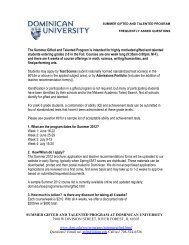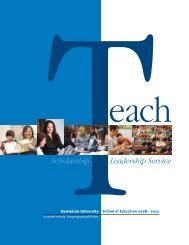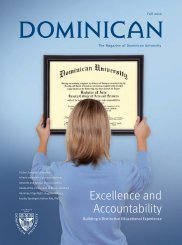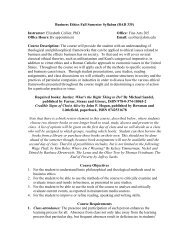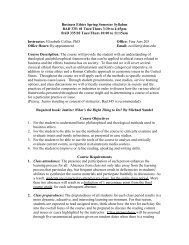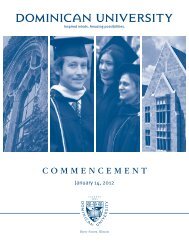Inside Parmer Hall: The Academic Impact - Dominican University
Inside Parmer Hall: The Academic Impact - Dominican University
Inside Parmer Hall: The Academic Impact - Dominican University
You also want an ePaper? Increase the reach of your titles
YUMPU automatically turns print PDFs into web optimized ePapers that Google loves.
On August 30, 2007, <strong>Dominican</strong><br />
<strong>University</strong> dedicated John C.<br />
and Carolyn J. <strong>Parmer</strong> <strong>Hall</strong>.<br />
Among the dignitaries attending were<br />
His Eminence Francis Cardinal George,<br />
OMI (who led the blessing ritual),<br />
US Representative Danny K. Davis,<br />
18 www.dom.edu<br />
DEDICATION CEREMONIES<br />
PARMER HALL<br />
Village of River Forest Board of<br />
Trustees President Frank M. Paris and<br />
<strong>Dominican</strong> <strong>University</strong> Trustee Emerita<br />
Carolyn Noonan <strong>Parmer</strong> ’52, for whom<br />
(along with her late husband) the<br />
new building is named.<br />
On Rosary Sunday, October 7, 2007, the <strong>Dominican</strong> <strong>University</strong><br />
community gathered to dedicate Founders’ Court—<strong>Parmer</strong> <strong>Hall</strong>’s<br />
tribute to the <strong>Dominican</strong> sisters who shaped the school. <strong>The</strong><br />
court, supplemented by a wall of remembrance in Shaffer Silveri<br />
Atrium, demonstrates how the founders’ ideals and efforts remain<br />
central to today’s institution. During the ceremony, Sr. Clemente<br />
Davlin, OP ’50, delivered a memorial to the university’s “founding<br />
mothers” and those who followed. Her speech is adapted here.<br />
Today we celebrate the members of the Congregation of the Most<br />
Holy Rosary, our sisters who loved this place into being. But<br />
especially, as we dedicate Founders’ Court, we remember those<br />
sisters who have worked and taught for Rosary and <strong>Dominican</strong>.<br />
I think of Sr. Mary Aquinas Devlin, who became an internationally<br />
respected scholar, a Guggenheim Fellow whose edition of the Latin<br />
sermons of a fourteenth-century bishop, friend of Chaucer, was<br />
published by the Royal Historical Society and is still the standard<br />
edition. I think of Sr. Reparata Murray, founder of our library school,<br />
called to Rome to help reorganize the cataloging of the Vatican<br />
Library; of Sr. Alberic coming home from Yale to teach generations<br />
of chemists (including women who succeeded in the then-rare<br />
feat of entering medical school); of Sr. Greg, whose love of theater<br />
still burns in her alums; of artist-faculty like Sr. Catherine Wall, Sr.<br />
Guala, Sr. Felix, adorning the college with paintings, mosaics and<br />
vestments. I remember Sr. Maristella convincing colleagues of the<br />
need for a psychology department. When I was an undergraduate,<br />
everyone, no matter what her major, took Sr. Thomasine’s first<br />
economics class. She was a scholar, a consultant to the White<br />
House, but what a teacher!<br />
We know that in 1934 the faculty offered almost<br />
1,000 people free courses in the depths of the<br />
Depression, and that in the same decade, determined<br />
to begin to create racial diversity, they invited black<br />
sisters as students. We remember hearing about<br />
Sr. Vincent Ferrer walking the picket line at the<br />
stock yards for workers’ rights, and Sr. Mary Ellen<br />
O’Hanlon, passionately attacking racial myths with<br />
her biological expertise long before the civil rights<br />
movement, and those of us who were here saw Sr.<br />
Albertus Magnus become the target of vilification in<br />
her last years because of her work for women. Most<br />
of you remember Sr. Paul; I remember her in her<br />
old age insisting on coming with me to the murder<br />
trial of a student’s brother who in self-defense had<br />
inadvertently killed his attacker. I pleaded with her<br />
not to come, because she was frail and in pain, but<br />
she said, “I’m coming, dear. You see, if you go alone, they will only<br />
think he happens to have one friend who is a sister. If I go with you,<br />
they will think a whole community stands behind him.”<br />
<strong>The</strong>y did all this—and much more—out of love: love for this place,<br />
certainly; love for their students and their world; and most of all,<br />
as Mary did, out of love for God. <strong>The</strong>se founders have not gone<br />
away from here, even the ones who have died. <strong>The</strong>y are, as the<br />
Eucharistic liturgy tells us, part of a great “cloud of witnesses” in the<br />
communion of saints, of which you and I are part. <strong>The</strong>y are present<br />
in this place, watching us, praying for us, urging us on, helping us.



